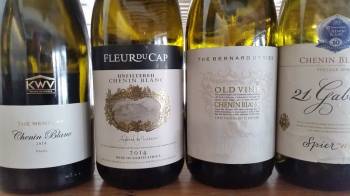SA wine corporates in the spotlight
By Christian Eedes, 14 December 2015
“It’s one thing to make 4 000 litres of high quality wine and another altogether to make 40 000 litres,’ observed Spier cellarmaster Frans Smit before a tasting of top-end Chenin Blanc and Pinotage as made by South Africa’s big wine companies, these being Bellingham The Bernard Series from DGB, Fleur du Cap Unfiltered from Distell, The Mentors from KWV and 21 Gables from Spier.
When it came to the four examples of Chenin Blanc, the overall quality was extraordinarily high although the spread of styles was perhaps wider than expected. “Chenin is meant to be South Africa’s white wine calling card and I always have to ask myself whether the diversity that it shows is to our benefit or detriment,” said KWV cellarmaster Johann Fourie.
“At entry level, similarity of style is probably an advantage when it comes to ensuring commercial success but if you’re trying to make thought-provoking, memorable wine, then you don’t want to be pigeon-holed,” said François Rautenbach, head of Singita’s premier wine programme.
Was SA Chenin now established as world-class or was there still work to do? The feeling around the table was that while the wines were intrinsically very good, there was still a need for better “story telling” when it came to getting consumers to engage with the wines.
Moving on to the flight of Pinotage, enthusiasm was more guarded. Rautenbach reported that Singita guests were drinking it with enthusiasm while visiting, a sign of improvements in quality, but were still not ordering it in meaningful quantities for home cellaring. “Cab and Cab blends still rule. If they’re going to take money out of their pocket, they want an extra sense of security.”
The four Pinotages were all relatively well executed but weren’t “life changing”, tending to show plenty of power and weight, smoothness of texture and little nuance. Whereas the Chenin revolution was well established going back at least 10 years, if not longer, advancements in Pinotage were more recent and off a low base. Whereas the Chenins were compelling, the Pinotages felt clinical as if the winemaking teams were scared to get it wrong. “The challenge is to make Pinotage more ‘palatable’ – these feel highly extracted and hence very dry,” proffered Fourie.
Smit, overseeing some 32 000 litres of Chenin (grapes from Durbanville) and 40 000 litres of Pinotage (grapes from Faure) under the 21 Gables label had the last word: “It’s about having a substantial offering from South Africa as opposed to these mythical wines that everybody talks about but nobody gets to drink.”








Comments
0 comment(s)
Please read our Comments Policy here.